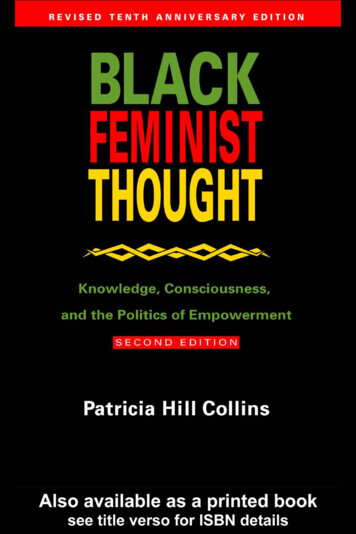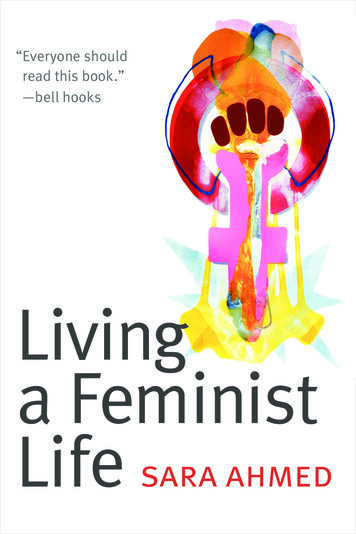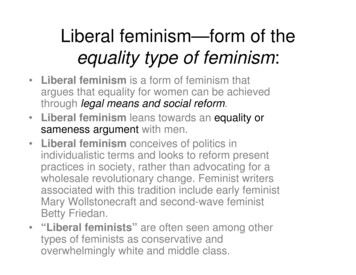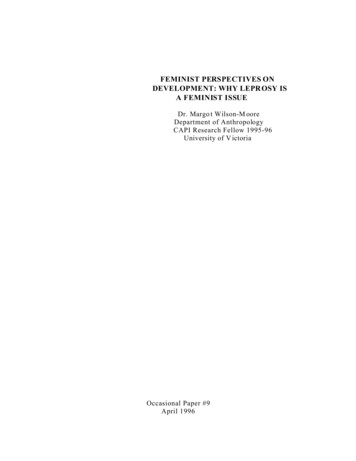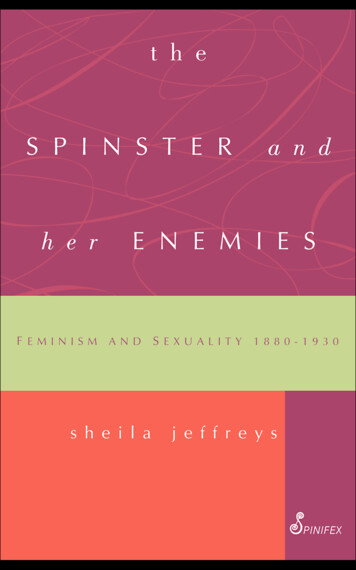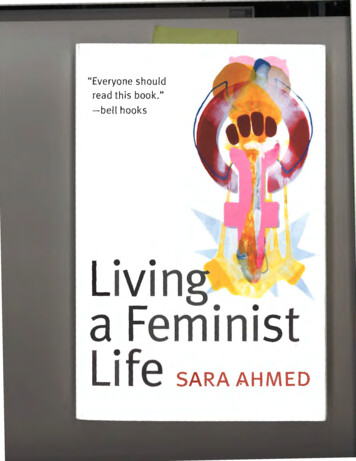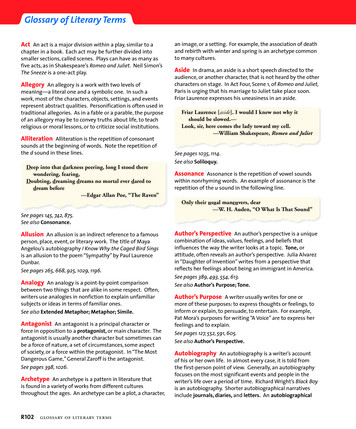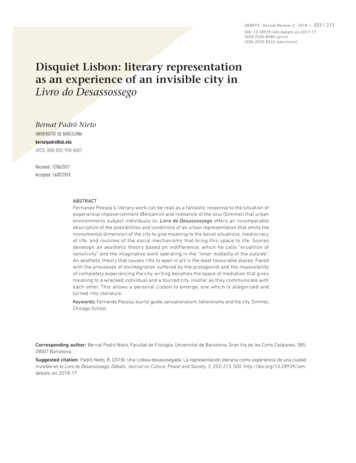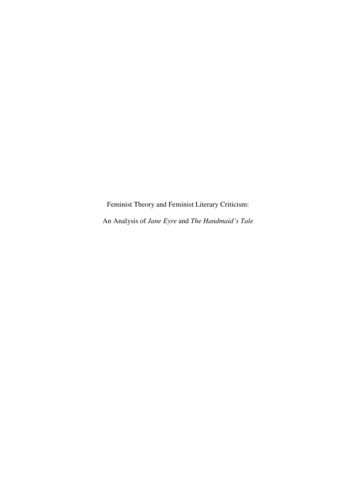
Transcription
Feminist Theory and Feminist Literary Criticism:An Analysis of Jane Eyre and The Handmaid’s Tale
Camilla V. Pheiffer & Maiken S. MyrrhøjProfessor Mia RendixMaster’s Thesis in English3 June 2019SummaryIn this thesis, we analyse how women are portrayed in two novels penned over a centuryapart using mainly feminist theory and feminist literary criticism. By gathering a historical contextregarding feminism and describing the ideas and theories by Hélène Cixous, Robin Lakoff, Simonede Beauvoir and Judith Butler, we have been able to analyse Charlotte Brontë’s Jane Eyre from1847 and Margaret Atwood’s The Handmaid’s Tale from 1985. In our comparative analysis of thetwo novels, we discovered that they had several similarities despite being written over a centuryapart. Both novels portray a society in which women are the inferior gender and religion plays adominant part. Both main characters represent ordinary women in their respective societies, andthey are both restricted in terms of opportunities, actions and even their language, which makesthem feel imprisoned. Furthermore, by discussing the theorists’ personal bias and reflecting on ourchoices, we identified the advantages and disadvantages of using newer theory on older works ofliterature and using different types of theories. We have been able to discuss the possibilities andlimits of feminist literary criticism. As a result of this, we concluded that we are able to analyseolder works thoroughly based on the terms, ideas, and methods introduced with newer theories. Inaddition, we concluded that using different types of theories can broaden your analysis, and it turnsout that the theories are interwoven, which makes it evident to connect them in an analysis.However, we face the risk of over-analysing and applying theory and meaning that was not indentedin the first place, which is why we must be cautious in our argumentation.
Myrrhøj & Pheiffer 1Table of ContentsIntroduction . 3Theory . 4Feminism . 4Waves of Feminism . 6Women’s Writing . 10Écriture feminine . 10“The Laugh of the Medusa” by Hélène Cixous . 13Language and Woman’s Place by Robin Lakoff . 19Gender: Women’s role and conditions . 22The Second Sex by Simone de Beauvoir . 22Gender Trouble by Judith Butler . 25Analysis. 30Jane Eyre . 30Equality, Society and Gender . 30Religion . 53Women’s Writing . 58The Handmaid’s Tale . 64Equality, Society and Gender . 64Religion . 91Women’s Writing . 97
Myrrhøj & Pheiffer 2Comparative Analysis and Discussion. 104Discussion . 111Personal Bias . 111Reflection and Critical View on the Theories . 123Conclusion . 130Works Cited . 134
Myrrhøj & Pheiffer 3IntroductionThroughout history, a major focus within feminism has been on the inequalitybetween the genders in their respective society. What are the reasons for this inequality andwho is to blame? This is a question feminists and philosophers have attempted to answersince the early 1800s, after French philosopher Charles Fourier coined the term ‘feminism’ in1837. Since then, feminism has developed into theory and to what is now known as feministliterary criticism. It is a literary criticism like any other, but its perspective is feminism. Whenapplying feminist literary criticism to a text, one can discover a female narrative supported byits characters, themes, etc. It is through this specific literary criticism that one is able todeconstruct female characters and the way in which texts portray them. Furthermore, becauseof our contemporary knowledge regarding the history of feminism, we can apply thecontemporary society and its social roles of the time in which a text was written.One of the major works within feminism is the novel Jane Eyre by Charlotte Brontë(1847). The novel contains criticism regarding religion, society and social roles. While thenovel was written before the term ‘feminism’ was coined, it is nevertheless considered afeminist novel. Another feminist work that recently attracted attention is the novel TheHandmaid’s Tale by Margaret Atwood (1985). Like Jane Eyre, The Handmaid’s Talecontains criticism regarding religion, society and social roles. Despite being written 138 yearsapart, they share similarities within their criticism, which is one of the reasons for choosingthese two novels.In 1949, French feminist and philosopher Simone de Beauvoir wrote her book TheSecond Sex, which discusses women’s inferiority throughout history and how women areconsidered to be the other. In 1975, American feminist and linguistics professor RobinLakoff wrote her book Language and Woman’s Place, where she discusses and analyses therelationship between gender and language. Also in 1975, French feminist and philosopher
Myrrhøj & Pheiffer 4Hélène Cixous wrote her essay “The Laugh of the Medusa”, in which she discusses ‘écriturefeminine’ and encourages women to write themselves in order to reclaim their body. In 1990,American feminist and philosopher Judith Butler wrote her book Gender Trouble: Feminismand the Subversion of Identity, where she states that gender is socially constructed, and sheintroduces her term ‘gender performativity’. All four feminists and their theories share acommon focus on women’s role within society.This thesis focuses on feminist theory and feminist literary criticism, and the analysistakes up a dominant part of the thesis. Including an historical overview of feminism and anaccount of the prominent feminist theories, this thesis analyses how the two novels/authorsportray women within their respective societies, and their conditions, role and place byprimarily using feminist literary criticism. Thereafter, we discuss the similarities anddifferences between the two novels in a comparative analysis and discussion. We furthermorediscuss how the portrayals of women in the novels compare to the periods in which they werewritten. Lastly, we examine the context in which the theories were written and discuss thesignificance thereof. We also discuss the possibilities and limits of feminist literary criticism,and the pros and cons of including different types of theories when analysing a literary work.TheoryFeminismThe term ‘feminism’ is unfortunately associated with extremists and man-haters. Wehave observed this tendency in our personal lives and, to our surprise, men and women sharethis prejudice about feminism. We wondered when, how, and why the term ‘feminism’achieved such negative associations, which is why we would like to examine the history offeminism, its origin and core values and principles. In Western culture, ”the core of feminismis the belief that women are subordinated to men [ ] Feminism seeks to liberate womenfrom this subordination and to reconstruct society in such a way that patriarchy is eliminated
Myrrhøj & Pheiffer 5and a culture created that is fully inclusive of women’s desires and purposes” (Edgar &Sedgwick 124). Since its inception, the focus of feminism was the fight for women’s politicaland economic equality (124). In the nineteenth century, feminism gained attention with theSuffragette movement, and “the twentieth century saw the proliferation of civil rightsmovements and groups campaigning for economic equality who focused on the issues of statewelfare for mothers, equal education and equal pay” (124). As feminism developed andscholars began to pay attention, different areas within the term began to emerge, such asfeminist theory and feminist literary criticism.Historian Rosalind Delmar believes that both feminists and non-feminists have takenthe meaning of the term ‘feminism’ for granted and that the meaning has been assumedbecause people regarded it as self-evident. Thus, “[ ] the assumption that the meaning offeminism is ‘obvious’ needs to be challenged. It has become an obstacle to understandingfeminism, in its diversity and in its differences, and in its specificity as well” (Kolmar &Bartkowski 27). As a society, we need to start defining feminism and be more specific in thisdefinition because it is clear what happens when people have to assume the meaning – thenegative associations grow and spread widely and the notion of feminism is misunderstoodand misrepresented. Delmar suggests an example of how a basic definition of feminism couldbe constructed: “Many would agree that at the very least a feminist is someone who holdsthat women suffer discrimination because of their sex, that they have specific needs whichremain negated and unsatisfied, and that the satisfaction of these needs would require aradical change (some would say a revolution even) in the social, economic, and politicalorder” (27). She concedes that it becomes more complicated as there are different branches,approaches and focuses of feminism. Twenty-first century feminism is in constantdevelopment and the fourth wave of feminism is roaring ahead.
Myrrhøj & Pheiffer 6Waves of FeminismWendy Kolmar and Frances Bartkowski, both professors who study gender studies,have described the waves of feminism in their book Feminist Theory: A Reader (2005). Theybegin by defining the women’s role at the end of the eighteenth century and how “mostwomen in the United States and Great Britain had no public legal existence. They were eitherdaughters identified by their fathers’ status or wives identified by their husbands” (Kolmar &Bartkowski 62). At this point, the term ‘feminist theory’ was not used, and the call forwomen’s rights were not taken seriously. In 1792, Mary Wollstonecraft published hergroundbreaking book Vindication of the Rights of Woman, in which she argues that womenshould be eligible for education in the same way that men are. Men should regard their wivesas companions, not simply as their wives, and she calls for equality between the sexes. Themain struggle of the nineteenth century for women was the Suffragette movement, which“began in the United States with the 1848 Seneca Falls meeting and continued through 1920,when the ratification of the 19th Amendment gave U.S. women the vote” (62). They foughtfor the right for women to own property, gain custody of their children, be able to file fordivorce and be eligible for education (62). Nineteenth-century writing about womenaddressed how their situation “was shaped by urbanization and industrialization [ ] Forworking-class women, urbanization meant factory or service work at low wages and in poorconditions, as well as the need to feed and care for a family under these circumstances” (6263). Working-class women who arrived in the cities in search of work had to face the sadreality that the only work available for them was prostitution (63). This sparked muchconcern in the United States and Great Britain, but these concerns and arguments laterevolved to become women “fighting for [ ] access to birth control and their right to makedecisions about their own sexuality” (63). By 1920, suffrage had brought about significantchange for women. They were able to access better education and had more legal rights.
Myrrhøj & Pheiffer 7The time after the 1920s is considered the “doldrums” of American feminism (136).The suffragetteswere disappointed to discover that the women’s vote did not radically alter theoutcome of elections, that women voted in relatively small numbers and, forthe most part, with their husbands, fathers, and brothers. At the same time,suffrage organizations were disbanding and their members dispersing into avariety of organizations. The image of the “flapper” suggests a 1920s womanwho is socially and sexually freer but is not a political activist in the way hersuffragist foremothers might have hoped (136).After the Second World War, the organisation known as WILPF (Women’sInternational League for Peace and Freedom) were able to help found the United Nationswith the help of powerful women such as Eleanor Roosevelt (136). In the 1950s, “AfricanAmerican women and a few white women became involved in the beginning of civil rightsactivism” (136). It is also around this time that women gained access to higher education and“academically trained women working in specific fields were beginning to producesubstantial writing about women and feminism” (136); Simone de Beauvoir was one suchwriter. Overall, the mid twentieth century demonstrated how culture and ideology made themaking of women (137). The 1960s were a defending decadeof social upheaval in the United States marked by the assassinations ofPresident John Kennedy in 1963 and of Martin Luther King, Jr. and RobertKennedy in 1968. Movements for civil rights and gay rights and against theUnited States’ escalating military involvement in Vietnam strengthened asdecade progressed [ ] Many of the women who became active in thewomen's movement in this decade learned political activism in these othersocial justice movements, where they also experienced sexism firsthand (196).
Myrrhøj & Pheiffer 8In this decade, women of colour became active within the civil rights movement andstarted writing feminist theory. They also established organisations such as the NationalBlack Feminist Organization (196). The work “of radical feminists and lesbian feminists wasessential to development of feminist thought in this period [ ] their analysis of thesex/gender system, and particularly of sexuality and reproduction as the root causes ofwomen’s oppression [ ] crystallized the notion that ‘the personal is political’” (196-197). Inthe 1970s, women were closer to equality, as “the first women’s studies programs werecreated in these years, as were rape crisis centers and hotlines, battered women’s shelters,women’s centers and women’s bookstores” (197). However, the most significant win forwomen in the 1970s was the legalisation of women’s right to abortion.The mid 1970s is a defining period for feminist theory and its development.Groundbreaking work was published, such as Cixous’ “The Laugh of the Medusa”. Thisessay defines “the span of feminist thinking over the next decade” (290). In the 1980s,various rifts began to emerge within feminism and its development. These rifts focused onrace, sexuality and activism, and “conflicts between lesbians and straight women overseparatism, heterosexism, and the role of men in the feminist movement tore organizationsapart” (291). Near the end of the 1980s,feminism and women’s studies could reasonably be said to have made asubstantial impact inside and outside the academy. Women could mark realincreases in their access to most areas of education and employment. A largepercentage of colleges and universities had women’s studies programs andsome had begun to establish graduate degrees in the field (382).The end of the 1980s also saw the emergence of the term ‘grrls’ in what is consideredthe third wave of feminism. These women regarded themselves as strong and independent.The end of the 1980s consisted of women continuing “to debate questions that have been
Myrrhøj & Pheiffer 9with us for more than a hundred years. Though new voices continued to enter its multilayeredconversation, feminist theory & scholarship had clearly, by the end of this period, traced out afield of inquiry that has quite thoroughly permeated both what we know and how we know it”(383).The dawn of a new millennium “brought feminist theory into dialogue with ideas andstruggles that had been glimpsed in earlier decades but became visible in this period in waysthat none [ ] could have foreseen” (530). There is a significant debate concerning“questions of the relationship among sexuality, the body and the law surfaced repeatedly indebates about gay and lesbian unions and the ‘defense’ of marriage; reproductive rights andsexual abuse; social welfare and health care; a continuing worldwide traffic in women; andthe fluidity or fixity of transgender and transsexual identities” (530).At the beginning of the 2000s, there was a shift in the attention from women studiestowards gender studies (530). The focus turned to embracing one’s individualism andaccepting a diversity regarding gender and identity. The end of the 2010s is considered thebeginning of the fourth wave of feminism, in which technology holds the power. Womenpromote their agendas and their feminism through social media and platforms. The majorfocuses of this wave are gender equality, sexual assault and sexual harassment. In 2014, theHeForShe campaign was established to promote gender equality. The #MeToo movementgained attention in 2017, when sexual-abuse allegations were made against HarveyWeinstein. The movement is opposed to sexual assault and sexual harassment, and theseissues attracted attention by using social media and technology. Technology is a major tool inthe fourth wave and through it, feminism can reach people in an unprecedented manner.
Myrrhøj & Pheiffer 10Women’s WritingÉcriture feminineÉcriture feminine is regarded as the feminine style of writing and is the French termfor ‘women’s writing’. Ann Rosalind Jones states in her article Writing the Body: Toward anUnderstanding of “L’Écriture Feminine” (1981) that French feminists “believe that Westernthought has been based on a systematic repression of women’s experience. Thus theirassertion of a bedrock female nature makes sense as a point from which to deconstructlanguage, philosophy, psychoanalysis, the social practices, and direction of patriarchal cultureas we live in and resist it” (Jones 247). The term originated in France during the feministliterary theory wave, and feminist French scholars Hélène Cixous, Luce Irigaray and JuliaKristeva coined the term in their discussion on what makes literature feminine. The threescholars share “a common opponent, masculinist thinking; but they envision different modesof resisting and moving beyond it” (248). They share the same belief that man is the centre ofthe universe by their own accord. Women therefore need to write and reclaim their bodies.Edgar and Sedgwick state in Cultural Theory: The Key Concepts (2007) that écriturefeminine, isa form of writing and reading that resists being appropriated by the dominantpatriarchal culture. It is argued, developing on the psychoanalysis of Lacan,that patriarchal culture privileges a hierarchical way of thinking, grounded in aseries of oppositions (such as male/female; culture/nature;intelligible/sensitive; active/passive), with the male dominant over the female(Edgar & Sedgwick 102-103).The fundamental ideas behind écriture feminine originate in psychoanalysis, and it questionsold traditions and patterns of common society. According to biology, men are physicallystronger than women are, and before écriture feminine, “the male is active and looks, in
Myrrhøj & Pheiffer 11comparison to the passive female who is merely observed. Femininity is therefore onlypresent as it is observed by the male” (103). Femininity is only coherent in the language ofmen, and it is through men and their superiority in society that women and their femininityare passive and considered non-present to the women herself (103). The two fundamentalideas about écriture feminine is that woman must reclaim her body, because “the womansimply cannot make sense of herself in a language that is designed to articulate andconceptualise masculinity” (103).Together, Cixous, Irigaray and Kristeva establish a common ground for femininewriting in terms of the language itself, the feminine body, feminine sexuality andmotherhood. Cixous writes from a psychoanalytic perspective, Irigaray from a philosophypoint of view and Kristeva from both a semiotic and psychoanalytical view. They agree that“resistance does take place in the form of jouissance” (Jones 248). ‘Jouissance’ beingphysical or intellectual enjoyment. However, only Cixous and Irigaray agree that womenhistorically have been limited to being sexual objects for men, such as virgins, prostitutes,wives and mothers, and “they have been prevented from expressing their sexuality in itself orfor themselves” (248).Cixous’ “The Laugh of the Medusa” marked the beginning of écriture feminine anddeconstructed the feminine language within a male discourse. In her essay, she addresses thenotion that women primarily are the inferior sex. Women are a self-love for the man, and shestates that “They have made for woman an antinarcissism! A narcissism which loves itselfonly to be loved for what woman haven’t got! They have constructed the infamous logic ofantilove” (Cixous, “The Laugh of the Medusa” 878). Women are other to men, and theirfemininity is present through the eyes of men. However, “she is convinced that women’sunconscious is totally different from men’s, and that it is their psychosexual specificity thatwill empower women to overthrow masculinist ideologies and [ ] create new female
Myrrhøj & Pheiffer 12discourses” (Jones 251). Irigaray, like Cixous, contends that women are other to men andstates that a woman is “infinitely other in herself” (250). She argues that because women“have been caught in a world structured by man-centered concepts, have had no way ofknowing or representing themselves. But she offers as the starting point for a female selfconsciousness that facts for women’s bodies and women’s sexual pleasure, precisely becausethey have been so absent or so misrepresented in male discourse” (250). Because womenhave been denied their bodies and therefore access to their sexuality and femininity, theyhave a “problematic relationship to (masculine) logic and language” (250). Irigaray's ideasemphasise the physical and sexual aspects of the woman, and she believes that for the womanto regain her sexuality, she must proclaim her jouissance and break from the man-centredworld. Kristeva “finds in psychoanalysis the concept of the bodily drives that survive culturalpressures towards sublimation and surface in what she calls “semiotic discourse”” (248).How do women fit into her semiotic discourse? According to Kristeva, women write ashysterics because they are outsiders to a male-dominated discourse (249). She contends thatwomen are “likely to involve repatriate, spasmodic separations from the dominatingdiscourse, which, more often, they are forced to imitate” (249). Therefore, Kristeva states thatwomen should not “work out alternative discourses” (249) but should rather “persist inchallenging the discourses that stand” (249). Women reclaiming their body and sexuality issomething that Cixous, Irigaray and Kristeva share common ground on but to differentextents:Kristeva does not privilege women as the only possessors of prephallocentricdiscourse, Irigaray and Cixous go further: if women are to discover andexpress who they are, to bring to the surface what masculine history hasrepressed in them, they must begin with their sexuality. And their sexuality
Myrrhøj & Pheiffer 13begins with their bodies, with their genital and libidinal difference from men(252).For women to create a new discourse and become independent from the discourse of men,they must write their bodies. The female body and its sexuality are the source of femalewriting (252).The three French theorists are challenging “feminist theory and literary selfconsciousness that goes far beyond the body and the unconscious” (260). Jones also makesthe criticism that in order to understand their ideas and the fundamental aspects of écriturefeminine, one must be familiar with “male figureheads of Western culture to recognize theintertextual games played by all these writers; their work shows that a resistance to culture isalways built, at first, of bits and pieces of that culture, however they are disassembled,criticized and transcended” (260). Écriture feminine draws its ideas from psychoanalysis andfrom the likes of Sigmund Freud and Jacques Lacan, and without a clear understanding ofpsychoanalysis and the ideas of Freud and Lacan, it may be difficult to understand écriturefeminine.“The Laugh of the Medusa” by Hélène CixousTo understand and interpret Cixous’ critical feminist essay “The Laugh of theMedusa”, it is important to be familiar with the Greek myth about Medusa; in many ways,she has become a symbol of feminism. Modern feminism has transformed Medusa from arape victim into a heroine.In Ovid’s Metamorphoses, Medusa originally was the strong, beautiful guardian andprotector in the house of Athena, and as such, she was expected to remain pure and to resisttemptation. While at the Parthenon and in Athena’s care, Medusa attracts the attention of thegod of the sea, Poseidon, who rapes Medusa at the house of Athena. However, Athena doesnot view it as rape but as Medusa breaking her purity vow that she made when she initially
Myrrhøj & Pheiffer 14became Athena’s guardian. Athena therefore punishes Medusa, turns her hair into snakes andcurses her. Every time a man would gaze upon Medusa, he would be frozen and turn to stone.Medusa flees Parthenon, never to return. Gradually, Medusa transforms into the monster thatis her appearance. However, if she was stripped of her body and sexuality, why does Cixoussuggest that Medusa has a reason to laugh when, according to old myths, she has everyreason to cry? The myth introduces us to two different Medusas: the guardian and themonster. The Medusa who was admired as a strong, beautiful guardian and the Medusa whois feared by women and, especially, men. Like the feminists today, Cixous chose the Greeklegend of Medusa because she wanted to revise the myth and write Medusa a new story – tohelp Medusa reclaim her body and sexuality.Cixous is one of the first feminist theorists to analyse Medusa and her myth in acritical essay. By using the myth of Medusa, she makes a case against the narrative of menand blames it for transforming Medusa into a monster instead of celebrating the heroine thatshe was before Athena’s curse. In her essay, she encourages women to reclaim their bodiesthrough writing and to break with the patriarchy. Women need to write their own story anddevelop a female narrative – a narrative without bias or social stigma. She starts her essaywith a paragraph that introduces her focus:I shall speak about women’s writing: about what it will do. Woman must writeher self: must write about women and bring women to writing, from whichthey have been driven away as violently as from their bodies – for the samereasons, by the same law, with the same fatal goal. Woman must put herselfinto the text – as into the world and into history – by her own movement(Cixous, “The Laugh of the Medusa” 875).“Woman must write woman” (877), says Cixous. She must write herself. With thefemale narrative, women can reclaim their bodies and sexuality. Cixous states that, with the
Myrrhøj & Pheiffer 15female narrative, women can break Western traditions and initiate a new feminist movement.Women should not look back at the myth of Medusa, but they should instead reinventMedusa and help her reclaim her body. Cixous declares that “the future must no longer bedetermined by the past. I do not deny that effects of the past are still with us. But I refuse tostrengthen them by repeating them, to confer upon them an irremovability the equivalent ofdestiny, to confuse the biological and the cultural. Anticipation is imperative” (875). She isaware that for women to create a narrative, they cannot avoid using the male narrative alongthe
Handmaid's Tale by Margaret Atwood (1985). Like Jane Eyre, The Handmaid's Tale contains criticism regarding religion, society and social roles. Despite being written 138 years apart, they share similarities within their criticism, which is one of the reasons for choosing these two novels.

